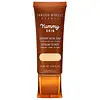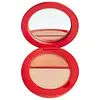What's inside
What's inside
 Key Ingredients
Key Ingredients

 Benefits
Benefits

 Concerns
Concerns

 Ingredients Side-by-side
Ingredients Side-by-side

Water
Skin ConditioningGlycerin
HumectantIsododecane
EmollientDimethicone
EmollientPropylene Glycol
HumectantCalcium Sodium Borosilicate
Caprylic/Capric Triglyceride
MaskingHydrogenated Polyisobutene
EmollientSqualane
EmollientXylitylglucoside
HumectantAnhydroxylitol
HumectantSr-Hydrozoan Polypeptide-1
HumectantSodium Hyaluronate
HumectantCeramide NP
Skin ConditioningPhytosterols
Skin ConditioningOpunta Dillenii Extract
Xylitol
HumectantCaprylhydroxamic Acid
Saccharide Isomerate
HumectantSodium Stearoyl Glutamate
CleansingTocopheryl Acetate
AntioxidantStearalkonium Hectorite
Gel FormingPropylene Carbonate
SolventCoco-Caprylate/Caprate
EmollientGlyceryl Stearate
EmollientBetaine
HumectantMagnesium Sulfate
Glyceryl Caprylate
EmollientPentylene Glycol
Skin ConditioningPolyglyceryl-4 Diisostearate/Polyhydroxystearate/Sebacate
EmulsifyingSorbitan Isostearate
EmulsifyingButylene Glycol
HumectantPhosphatidylcholine
EmulsifyingHydroxyacetophenone
AntioxidantEthylhexyl Hydroxystearate
EmollientCetyl PEG/PPG-10/1 Dimethicone
EmulsifyingTriethoxycaprylylsilane
Aluminum Hydroxide
EmollientPotassium Sorbate
PreservativePhenoxyethanol
PreservativeCI 77163
Cosmetic ColorantTitanium Dioxide
Cosmetic ColorantIron Oxides
Water, Glycerin, Isododecane, Dimethicone, Propylene Glycol, Calcium Sodium Borosilicate, Caprylic/Capric Triglyceride, Hydrogenated Polyisobutene, Squalane, Xylitylglucoside, Anhydroxylitol, Sr-Hydrozoan Polypeptide-1, Sodium Hyaluronate, Ceramide NP, Phytosterols, Opunta Dillenii Extract, Xylitol, Caprylhydroxamic Acid, Saccharide Isomerate, Sodium Stearoyl Glutamate, Tocopheryl Acetate, Stearalkonium Hectorite, Propylene Carbonate, Coco-Caprylate/Caprate, Glyceryl Stearate, Betaine, Magnesium Sulfate, Glyceryl Caprylate, Pentylene Glycol, Polyglyceryl-4 Diisostearate/Polyhydroxystearate/Sebacate, Sorbitan Isostearate, Butylene Glycol, Phosphatidylcholine, Hydroxyacetophenone, Ethylhexyl Hydroxystearate, Cetyl PEG/PPG-10/1 Dimethicone, Triethoxycaprylylsilane, Aluminum Hydroxide, Potassium Sorbate, Phenoxyethanol, CI 77163, Titanium Dioxide, Iron Oxides
Dimer Dilinoleyl Dimer Dilinoleate
EmollientDiisostearyl Malate
EmollientOctyldodecanol
EmollientC10-18 Triglycerides
EmollientC12-15 Alkyl Benzoate
AntimicrobialPolyglyceryl-10 Decaisostearate
EmollientHelianthus Annuus Seed Cera
EmollientJojoba Esters
EmollientPentaerythrityl Tetraisostearate
EmollientCera Microcristallina
Emulsion StabilisingSimmondsia Chinensis Seed Oil
EmollientSodium Hyaluronate
HumectantHelianthus Annuus Seed Oil
EmollientRicinus Communis Seed Oil
MaskingDisteardimonium Hectorite
StabilisingSynthetic Fluorphlogopite
Calcium Sodium Borosilicate
Propylene Carbonate
SolventMica
Cosmetic ColorantCI 77891
Cosmetic ColorantCaprylic/Capric Triglyceride
MaskingSqualane
EmollientTribehenin
EmollientKaolin
AbrasiveOryza Sativa Powder
Ethylhexyl Polyhydroxystearate
EmollientCoco-Caprylate/Caprate
EmollientTheobroma Grandiflorum Seed Butter
Skin ConditioningHydrogenated Ethylhexyl Olivate
EmollientPolyhydroxystearic Acid
EmulsifyingTocopherol
AntioxidantZingiber Officinale Root Extract
MaskingButyrospermum Parkii Butter
Skin ConditioningHydrogenated Castor Oil
EmollientBisabolol
MaskingStearalkonium Hectorite
Gel FormingCI 77491
Cosmetic ColorantCI 77007
Cosmetic ColorantDimer Dilinoleyl Dimer Dilinoleate, Diisostearyl Malate, Octyldodecanol, C10-18 Triglycerides, C12-15 Alkyl Benzoate, Polyglyceryl-10 Decaisostearate, Helianthus Annuus Seed Cera, Jojoba Esters, Pentaerythrityl Tetraisostearate, Cera Microcristallina, Simmondsia Chinensis Seed Oil, Sodium Hyaluronate, Helianthus Annuus Seed Oil, Ricinus Communis Seed Oil, Disteardimonium Hectorite, Synthetic Fluorphlogopite, Calcium Sodium Borosilicate, Propylene Carbonate, Mica, CI 77891, Caprylic/Capric Triglyceride, Squalane, Tribehenin, Kaolin, Oryza Sativa Powder, Ethylhexyl Polyhydroxystearate, Coco-Caprylate/Caprate, Theobroma Grandiflorum Seed Butter, Hydrogenated Ethylhexyl Olivate, Polyhydroxystearic Acid, Tocopherol, Zingiber Officinale Root Extract, Butyrospermum Parkii Butter, Hydrogenated Castor Oil, Bisabolol, Stearalkonium Hectorite, CI 77491, CI 77007
 Reviews
Reviews

Ingredients Explained
These ingredients are found in both products.
Ingredients higher up in an ingredient list are typically present in a larger amount.
Calcium Sodium Borosilicate is a bulking agent. It is considered a borosilicate glass; it is composed of powder or flakes of calcium and sodium borosilicates.
This ingredient is used to add volume, shine, and color to products. You'll most likely find this ingredient in makeup products.
According to in-vivo and ex-vivo studies done by a manufacturer, this ingredient works well with UV filters:
Learn more about Calcium Sodium BorosilicateThis ingredient is an emollient, solvent, and texture enhancer. It is considered a skin-softener by helping the skin prevent moisture loss.
It helps thicken a product's formula and makes it easier to spread by dissolving clumping compounds.
Caprylic Triglyceride is made by combining glycerin with coconut oil, forming a clear liquid.
While there is an assumption Caprylic Triglyceride can clog pores due to it being derived from coconut oil, there is no research supporting this.
Learn more about Caprylic/Capric TriglycerideCoco-Caprylate/Caprate is created from fatty coconut alcohol, caprylic acid, and capric acid.
It is a lightweight emollient. Emollients create a thin barrier on the skin to trap moisture in. This helps keep your skin hydrated and soft.
Once applied, Coco-Caprylate/Caprate is absorbed quickly and leaves a silky feel.
Coco-Caprylate/Caprate may not be fungal acne safe.
Learn more about Coco-Caprylate/CaprateThis ingredient is a solvent. It helps dissolve active ingredients and alter the texture of products.
Propylene Carbonate is commonly used in makeup and with clay, such as montmorillonite or bentonite.
Studies show this ingredient to be safe for cosmetics. When it is undiluted, it can cause skin irritation. (It is always diluted in skincare and makeup). This ingredient is water-soluble.
Propylene Carbonate is created from propylene glycol and carbonic acid.
Learn more about Propylene CarbonateSodium Hyaluronate is hyaluronic acid's salt form. It is commonly derived from the sodium salt of hyaluronic acid.
Like hyaluronic acid, it is great at holding water and acts as a humectant. This makes it a great skin hydrating ingredient.
Sodium Hyaluronate is naturally occurring in our bodies and is mostly found in eye fluid and joints.
These are some other common types of Hyaluronic Acid:
Learn more about Sodium HyaluronateSqualane is an emollient that helps the skin hold onto moisture. It's an oily liquid that occurs naturally in certain types of fish and plant oils.
Because squalane boosts hydration in the skin, it also comes with plenty of benefits: it is an antioxidant and can help fight free radicals and skin damage. Squalane is also found to have a detoxifying effect when applied.
Squalane comes from squalene, which occurs naturally within the sebum of our skin. It is one of the oils our skin produces to keep itself hydrated. Squalane is the hydrogenated version of squalene and has a longer shelf life.
Research shows that squalane is non-irritating (even at 100% concentration).
In general, it's a fantastic ingredient. It does a great job at hydrating the skin, and it's suitable for those with sensitive skin.
The source of squalane may impact malassezia / fungal acne. This is because olive oil derived squalane can contain impurities such as fatty acids and plant waxes. Sugarcane derived squalane is recommended for anyone with malassezia concerns.
Is squalane vegan?
This depends on the source. Squalane can be derived from both plants and animals. Most squalane used in skincare comes from plants.
Please note: the source of squalane is only known if disclosed by the brand. We recommend reaching out to the brand if you have any questions about their squalane.
Read more about squalene with an "e".
Is squalane an oil?
Squalane is often called an oil, but it’s technically not; it’s a hydrocarbon, meaning it’s only made of carbon and hydrogen, unlike true oils which are triglycerides made of fatty acids and glycerol.
The term “oil-free” isn’t regulated, so companies can define it however they want. Some exclude all oils, while others just avoid mineral oil or comedogenic oils.
While some people avoid oils thinking they cause breakouts, the right kind of oil (or oil-like ingredient like squalane) can actually help balance and hydrate your skin. It’s worth testing out simple oils or squalane to see what works best for your skin.
Learn more about SqualaneStearalkonium Hectorite is a clay-derived ingredient used to thicken a product and help create a gel-like texture.